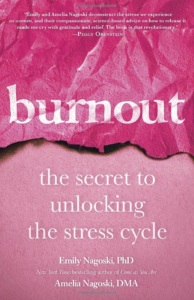In their book, Burnout: the Secret to Unlocking the Stress Cycle, twin sisters Emily and Amelia Nagoski offer us a plethora of useful strategies for dealing with stress. I heard them speak about this book during the 2019 Explore More Summit, a very cool online conference about joy and pleasure. I promptly pre-ordered it, and also bought the ebook version of Emily Nagoski’s previous book, Come as You Are: The Surprising New Science that will Transform your Sex Life. As a result of reading Come As You Are, I knew that I wanted to review Burnout before it even arrived.
I really wanted to read this book because, as someone staring down my last year before defending my thesis, burnout is a very real risk in my life. Like many other graduate students and academics, I struggle with anxiety and depression. While these issues are partly determined by my genetic makeup and my life experiences thus far, they also ebb and flow with the tides of immediate external stressors in my life (#sorrynotsorry for the ocean imagery). I was hoping that Burnout would give me strategies to decrease my anxiety and be less susceptible to burnout, and I wasn’t disappointed.
Burnout is absolutely fantastic. It reads similarly to Come as You Are, with an abundance of pop culture references and tl;dr (internet speak for “too long; didn’t read”) lists at the ends of chapters to highlight the main points. It also employs a fantastic device that Emily Nagoski debuted in Come as You Are: stories from real women combined into composite characters that help the reader to connect emotionally with the science. These passages show us how the series of stressors we experience can combine to create a life that leads to burnout, and how the strategies in the book might actually be implemented, speed bumps and all. These composite characters are presented as friends of Emily and Amelia, and the narrative passages about them are complete with dialogue, jokes, and the very real way that friends tease one another. In a book about complex neuroscience, this composite character device goes a long way towards making the book easy to digest.
The series of stressors we experience can combine to create a life that leads to burnout
The book also contains plenty of worksheets to help you implement the strategies of the book in your own life. The first helps you decide if you should quit something (their examples include a job, a relationship, a diet, and substance use), there is another for identifying what is within your own control in your life, and the final one encourages you to take stock of how you spend your time—in order to find the time to get sufficient rest.
I have to admit that I didn’t take the time to stop and write out my answers to all these worksheets, but there was one activity that grabbed me by the shoulders and shook me. In the chapter on “Meaning,” the Nagoski twins ask the reader to remember times in their life that they have faced hardships, and identify the inner characteristics and the external support systems that allowed them to overcome those hardships. They ask us, as readers, to tell ourselves our origin story, and to frame the narrative around our strength and resilience. In my own life, I’ve faced a number of upheavals in my living situation and my close relationships. In nearly all of these periods, I’ve turned to reading. This prompt to write my story to myself inspired me to journal about how important reading has been to me throughout my life. It was an emotional and cathartic experience.
The authors’ approach to reframing failure is an extremely useful tool for early career scientists. They introduce the concept of a “little monitor” in our brain that has expectations about how long something should take or how rapidly we should move towards a goal. This brain system keeps us chomping at the bit to reach our goals, but can also derail us into a bottomless pit of frustration and despair when our progress isn’t fast enough. Their approach to overcoming this is to deal with the uncontrollable things in your life with “positive reappraisal.” They explain that “Positive reappraisal…means deciding that the effort, the discomfort, the frustration, the unanticipated obstacles, and even the repeated failure have value—not because they are steps toward a worthwhile goal, but because you reframe difficulties as opportunities for growth and learning.” So when you don’t get the fellowship/grant/job, or all your experimental creatures die, or your paper needs major revisions, you can see those challenges as roadblocks, or you can see them as difficult circumstances that simultaneously provide opportunities for deeper learning. To revise an old adage, many things worth doing are really, really hard.
Many things worth doing are really, really hard.
I was excited to read this book and wanted to write a book review of it for the SWMS blog, but somehow along the way, reading the book and writing the review became one more thing on my extremely long to-do list. As the seasons started to turn in Massachusetts in late March, my stress about the passage of time and how much I was getting done for my science was ticking up. My mental health was declining, so I wondered how I could even be qualified to write this book review. Well, lucky for me, I caught a nasty spring cold and was bedridden for two days. This little local maximum of burnout helped me to see the places I needed to scale back, or to simply give myself permission not to be perfect.
I stayed in bed for two days with that cold. During the first, I slept a lot and took a lot of cold medicine. During the second day, I worked from home and napped—I was completely amazed that I could get just as much done while sick as I would on a normal day at the office. And then I realized that I hadn’t gone to any meetings, and I hadn’t spent hours on email, and I felt somehow both productive and rested. Since then, I’ve struggled to find ways to preserve my energy, but I’m starting to see how important it is to take care of myself so that I can stay in this game for a long time. And now I’ve got a trusty guidebook that I can turn to for advice.

